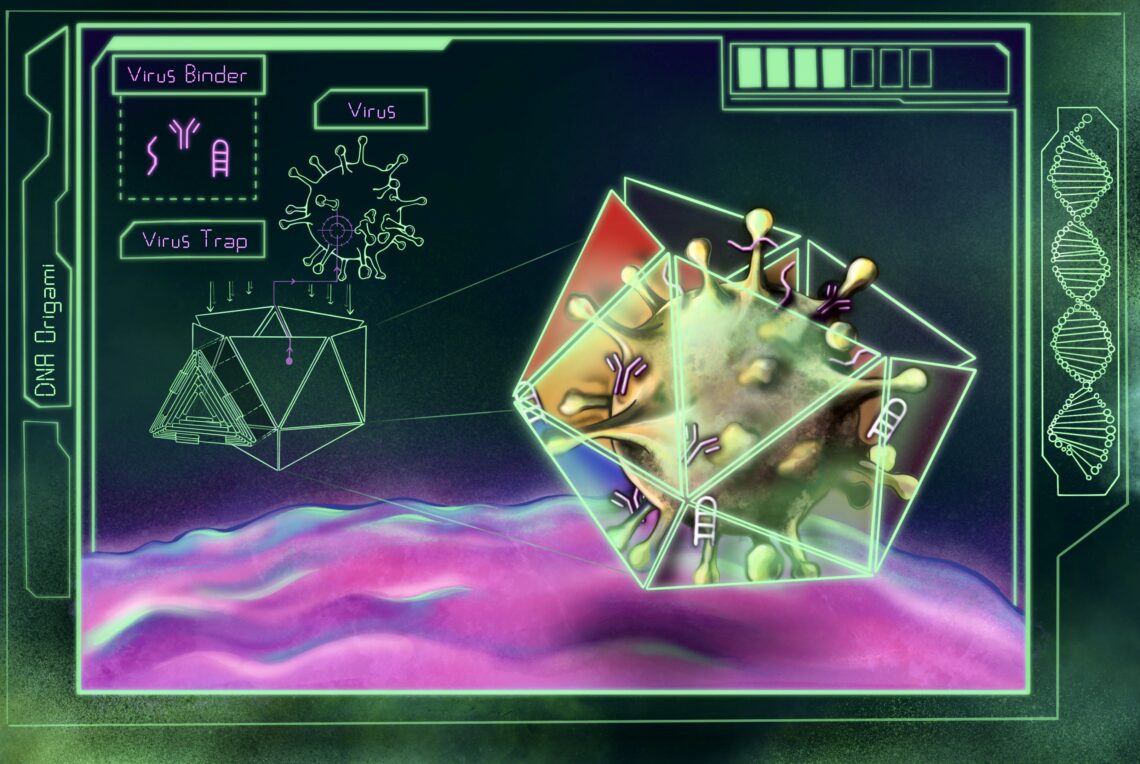The medical procession has long been baffled by viruses. Out of 200 plus known virus pathogens there are medications to treat acute infections of only about eight of them. HIV is one but it took researchers several decades to come up with therapeutics. When it comes to other viruses such as Dengue, Zika or deadly Marburg, there are no treatments. You either survive or you don’t.
Capsitec, a German synthetic biology startup spun out of the Technical University of Munich, hopes to change that by using DNA origami -the nanoscale folding of DNA to create arbitrary two- and three-dimensional shapes – to neutralize viruses. Viruses need host cells to replicate so the idea is to create molecular cages out of synthetic biological material that prevent the viruses from attaching to cells (see the illustration). The approach harnesses the power of DNA origami nanofabrication and AI-supported molecular designs to create shells with gaps that can trap entire virus particles, putting the viruses – not the human – into lock down.
If it works, the treatment could be applied to everything from influenza and human papillomavirus to Chikungunya and hepatitis, savings lives and preventing long term harms.
“Our shell platform provides a novel generic platform to derive antivirals that could have a major impact on human health,” says Capsitec co-founder Hendrik Dietz, a professor at the university and a specialist in biomolecular nanotechnology. “By small design changes, we can quickly adjust the shells to target different viruses, including new emerging viruses or virus strains. Consequently, the shells could provide a promising antiviral approach for existing viruses without an effective cure and future viral outbreaks.”
If it proves effective in human clinical trials the approach could be a big breakthrough. The common flu (influenza) virus still stumps the medical profession. Some 400,000 people die from it each year. Tamiflu, the brand name for a drug called oseltamivir, was supposed to curb hospitalizations and deaths but among over 6,000 flu patients across 15 studies, the 0.14-percentage point difference in hospitalization rate between those who took oseltamivir and those who did not was not significant, Emily McDonald, MD, MSc, of McGill University Health Centre in Montreal, and colleagues reported in a June issue of JAMA Internal Medicine.
It is important to develop a way to also deal with comparably “mild” viruses since these infections can also lead to long term health damage, says Dietz. For example, a study led by Stanford Medicine researchers has proved that the Epstein-Barr virus, a common type of herpes virus, triggers multiple sclerosis by priming the immune system to attack the body’s own nervous system.The study, published in Jan. 24, 2022 in Nature, shows that approximately 20% to 25% of patients with multiple sclerosis have antibodies in their blood that bind tightly to both a protein from the Epstein-Barr virus, called EBNA1, and a protein made in the brain and spinal cord, called the glial cell adhesion molecule, or GlialCAM.
New viruses pose other challenges. Take the case of the COVID outbreak. One of the greatest challenges in the battle against that virus was identifying novel or repurposed drugs that could effectively treat COVID-19 symptoms. It provoked a world-wide race to come up with a vaccine. In the meantime, millions of people died, and new, more virulent strains developed.
“As soon as you think you are on track with a vaccine or an antiviral the virus may have mutated, potentially rendering it ineffective. This makes antivirals not only technically challenging but also commercially challenging,” Dietz says. “Our approach is more robust against these risks and thus could be the answer.”
An Unlikely Trajectory
Capsitec was founded in 2021 as university spin-off by a team of leading experts in DNA nano-engineering, biophysics, virology, and business. “We came from an unlikely trajectory” says Dietz. The journey began with nano-engineering. building molecular devices and machines that can execute user-defined tasks. The approach, called DNA origami, refers to an assembly technique that folds single-stranded DNA template molecules into target structures, similar to the way the Japanese art of origami uses a small number of basic folds to combine paper in a variety of ways.
DNA origami enables the building of nanodevices that can be employed for making new discoveries in biomolecular physics and protein science. But first Dietz and his team had to figure out how to scale the process for mass production to make needed quantities for medical products. Once they succeeded to do this, they began seriously looking at how DNA structures could be used to trap viruses. Dietz and the Capsitec team devised ways to construct triangles out of DNA with sizes that are a thousand times smaller than a human hair. These triangles are the building blocks of the artificial shells. The triangles feature a LEGO-like pattern on their edges, enabling multiple triangles to bind to each other and build the shells. By varying the shape of the triangles and the LEGO-like pattern, the team can design shells of different sizes with defined openings which are needed for trapping viruses.
In the near-term Dietz envisions that the nanoscale DNA virus traps, once proven safe, would be injected into humans to deal with acute systemic virus infections. Eventually they might be used in nasal sprays or integrated into pills that can be ingested. The virus traps, along with the viruses, are broken up by the body naturally, he says. “Once they are trapped by the shell, viruses will become inert and degrade together with the shell,” he says.
From Theory to Therapeutics
DNA vaccines were tried in the past and proved to be comparably ineffective – but safe to use. Capsitec is taking a different approach with DNA molecules, but Dietz hopes that the fact that the DNA vaccines did not have any negative side effects will help convince regulators to fast track its development. “It we target an unmet critical need we hope to get to market pretty quickly,” says Dietz.
He estimates that approvals could take as little as three years if the company is able to skip phase III clinical trials by addressing unmet clinical needs and working with already approved components.
“Capsitec’s approach can be easily adapted to various viruses and combined with a wide range of virus-binding molecules, offering a broad-spectrum, highly adaptable treatment of acute infections,” says Dietz. Eventually he says the platform might also be used as a basis to make non-viral gene delivery vectors and programmable vaccines.
Capsitec has obtained an undisclosed loan from the German Ministry of Disruptive Innovation. It is currently in the process of raising venture capital funding.
“Just imagine how the world would change if we could reach a future where virus infections are no longer a concern,” says Dietz.
This article is content that would normally only be available to subscribers. Sign up for a four-week free trial to see what you have been missing.







